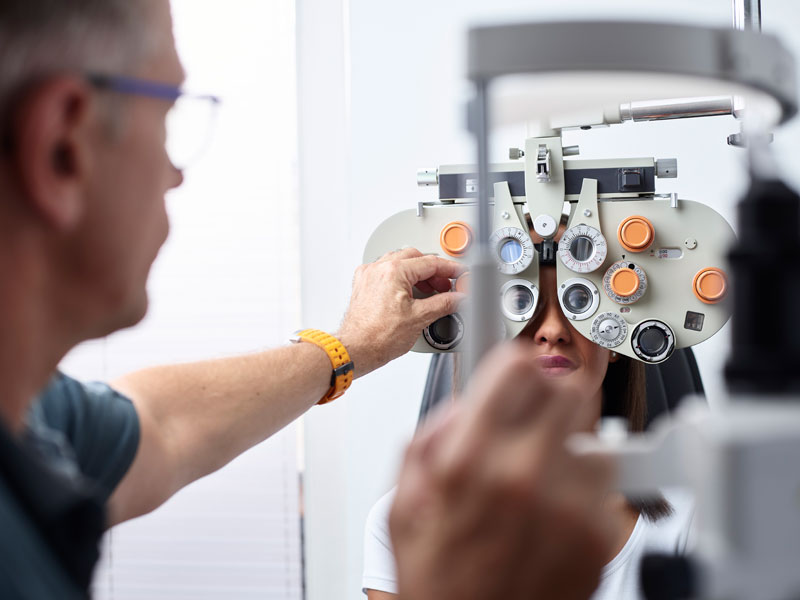The Importance of Regular Exams with an Eye Doctor Optometrist
Wiki Article
Discovering the most recent Technological Improvements in Optometry and What They Mean for Eye Doctors
From the precision of Optical Coherence Tomography to the nuanced insights offered by AI-driven diagnostic tools, these innovations are establishing new requirements in person evaluation and therapy. As these improvements permeate the practice, eye doctors are encountered with the challenge of embracing these devices to enhance individual results.Innovations in Diagnostic Equipment
Advancing the field of optometry, developments in analysis devices have actually revolutionized the means eye treatment experts evaluate and diagnose eye problems and aesthetic impairments. The previous years has experienced significant technological improvements, allowing more accurate and detailed assessments.An additional secret innovation is the introduction of advanced corneal topography systems, which map the surface area curvature of the cornea with precision. These devices are particularly useful for suitable contact lenses and identifying corneal disorders. Digital retinal imaging has actually changed conventional ophthalmoscopy, supplying detailed, scenic sights of the retina that promote detailed visual exams.
The development of wavefront aberrometry has likewise been crucial, enabling the analysis of refractive errors with unparalleled accuracy (Opticore Optometry). This modern technology assists in personalizing rehabilitative lenses and boosting medical end results for refractive surgical treatments. Jointly, these analysis innovations encourage eye doctors to supply exceptional client treatment, making certain very early treatment and customized treatment techniques, eventually improving visual wellness end results
AI in Person Monitoring
Building on the structure of innovative diagnostic devices, the consolidation of artificial knowledge (AI) in person administration stands for a transformative leap for optometry. AI systems are significantly utilized to boost effectiveness, precision, and personalization in person care.Moreover, AI-driven systems facilitate structured patient communications and management processes. Automated organizing, virtual consultations, and individualized follow-up plans not just enhance person fulfillment but also maximize time administration for practitioners. These systems can triage clients based upon the urgency of their problems, making certain that those in critical requirement obtain prompt attention.
Moreover, AI improves decision-making by supplying optometrists with evidence-based referrals and therapy pathways. By integrating data from electronic health and wellness records, AI tools use understandings that educate scientific choices, reducing the risk of errors and enhancing person end results. As AI continues to advance, its role in client administration will likely broaden, improving the landscape of optometric treatment.
Advancements in Retinal Imaging
In the realm of optometry, retinal imaging has experienced impressive technical advancements that are boosting diagnostic capabilities and client care. Technologies such as Optical Coherence Tomography (OCT) and fundus photography have transformed just how optometrists assess the retina and picture. OCT, particularly, gives high-resolution, cross-sectional photos of the retina, permitting for the comprehensive assessment of its layers. This ability is very useful for very early detection and administration of conditions like glaucoma, diabetic person retinopathy, and age-related macular deterioration.Improved imaging methods like OCT angiography are additional refining diagnostic precision. Opticore Optometry. Such advancements promote the identification of min retinal changes that could signify illness development.
Moreover, innovations in man-made knowledge are augmenting retinal imaging by allowing computerized analysis of big datasets. These systems help eye doctors in determining patterns a measure of pathology, thereby enhancing diagnostic precision and efficiency. Collectively, these advancements are changing retinal imaging into a keystone of modern eye care, improving end results and expanding restorative possibilities.
Teleoptometry's Expanding Duty
Teleoptometry is progressively coming to be a crucial component of eye treatment, driven by developments in digital communication and analysis tools. This is especially valuable in underserved and rural locations where accessibility to specialized eye care is typically limited.The integration of man-made knowledge (AI) further boosts teleoptometry, allowing the analysis of aesthetic data and aiding in the detection of ocular problems such as glaucoma and diabetic retinopathy. AI-powered formulas can quickly interpret complicated imaging data, providing optometrists with important understandings that reinforce medical decision-making.
Moreover, teleoptometry supports continuity of care through smooth integration with electronic health documents (EHRs), allowing eye doctors to keep comprehensive person histories. This ensures that individuals get consistent and personalized treatment even when seeking advice from different professionals.
Regardless of these advantages, obstacles continue to be, including making sure view it information security and handling person expectations. Nevertheless, teleoptometry represents a considerable stride in the direction of even more accessible, reliable, and patient-centered eye treatment. As technology develops, its role is positioned to expand additionally.

Future Patterns in Eye Treatment
A myriad of innovative fads is readied to reshape the future of eye treatment, driven by technical developments and the developing requirements of individuals. One considerable pattern is the integration of expert system (AI) in diagnostics, which promises to enhance the precision and performance of eye assessments. AI algorithms can analyze vast amounts of data from retinal images, possibly detecting problems like diabetic retinopathy and glaucoma earlier than traditional approaches.In addition, personalized medicine is gaining grip in optometry, with hereditary testing educating tailored therapy plans. This strategy intends to enhance person end results by customizing interventions to individual hereditary profiles. Wearable technology, such as wise get in touch with lenses, is also on the perspective, providing real-time surveillance of intraocular stress or glucose levels, hence offering continuous understandings into systemic and eye health.
The adoption of increased reality (AR) and digital truth (VR) in training and person education is an additional arising pattern. These innovations supply immersive experiences that can enhance understanding and skills both for people and optometrists. As these patterns advance, optometrists need to stay abreast of technological advancements to supply advanced treatment, ensuring better patient outcomes and contentment in the dynamic landscape of eye treatment.
Final Thought

Jointly, these diagnostic advancements great site empower optometrists to supply premium individual treatment, ensuring very early treatment and tailored treatment methods, eventually improving aesthetic health and wellness outcomes.

As these modern technologies proceed to develop, optometrists have to adapt and incorporate them right into method, ultimately enhancing operations efficiency and boosting the standard of eye care provided to people.
Report this wiki page